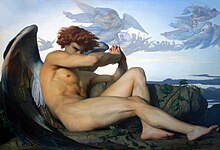Devil
[16] The Devil is identified with several figures in the Bible including the serpent in the Garden of Eden, Lucifer, Satan, the tempter of the Gospels, Leviathan, and the dragon in the Book of Revelation.
The Babylonian myth of a rising star, as the embodiment of a heavenly being who is thrown down for his attempt to ascend into the higher planes of the gods, is also found in the Bible and interpreted as a fallen angel (Isaiah 14:12–15).
[31] The Devil is a unique entity throughout the New Testament, neither identical to the demons nor the fallen angels,[32][33] the tempter and perhaps rules over the kingdoms of earth.
[34] In the temptation of Christ (Matthew 4:8–9 and Luke 4:6–7),[35] the devil offers all kingdoms of the earth to Jesus, implying they belong to him.
[50] In the Book of Revelation, a a dragon/serpent "called the devil, or Satan" wages war against the archangel Michael resulting in the dragon's fall.
The rational creatures are divided into angels and humans, both endowed with free will,[57] and the material world is a result of their evil choices.
[62] From the beginning of the early modern period (around the 1400s), Christians started to imagine the Devil as an increasingly powerful entity, actively leading people into falsehood.
For Martin Luther the Devil was not a deficit of good, but a real, personal and powerful entity, with a presumptuous will against God, his word and his creation.
David Joris was the first of the Anabaptists to suggest the Devil was only an allegory (c. 1540); this view found a small but persistent following in the Netherlands.
[67] The Devil as a fallen angel symbolized Adam's fall from God's grace and Satan represented a power within man.
[67] Rudolf Bultmann taught that Christians need to reject belief in a literal devil as part of formulating an authentic faith in today's world.
[69]John Arendzen (1909) in the Catholic Encyclopedia (1913) mentions that Eusebius accused Apelles, the 2nd-century AD Gnostic, of considering the Inspirer of Old Testament prophecies to be not a god, but an evil angel.
Some texts, such as the Apocryphon of John and On the Origin of the World, not only demonized the Creator God but also called him by the name of the devil in some Jewish writings, Samael.
[71] In the 12th century in Europe the Cathars, who were rooted in Gnosticism, dealt with the problem of evil, and developed ideas of dualism and demonology.
[72][73] In the Gospel of the Secret Supper, Lucifer, just as in prior Gnostic systems, appears as a demiurge, who created the material world.
[74] In Islam, the principle of evil is expressed by two terms referring to the same entity:[75][76][77] Shaitan (meaning astray, distant or devil) and Iblis.
[clarification needed] Iblis might either be regarded as the most monotheistic or the greatest sinner, but remains only a creature of God.
Iblis did not become an unbeliever due to his disobedience, but because of attributing injustice to God; that is, by asserting that the command to prostrate himself before Adam was inappropriate.
[86] According to the Quran, Iblis's disobedience was due to his disdain for humanity, a narrative already occurring in early New Testament apocrypha.
[89][76] Further, although Iblis is generally regarded as a real bodily entity,[90] he plays a less significant role as the personification of evil than in Christianity.
[93] Shaitan is also linked to humans' psychological nature, appearing in dreams, causing anger, or interrupting the mental preparation for prayer.
Also, the principle of shaitan is in many ways a symbol of spiritual impurity, representing humans' own deficits, in contrast to a "true Muslim", who is free from anger, lust and other devilish desires.
[94] In Muslim culture, devils are believed to be hermaphrodite creatures created from hell-fire, with one male and one female thigh, and able to procreate without a mate.
The rebellion against God, mentioned in the Quran, takes place on the level of the psyche that must be trained and disciplined for its union with the spirit that is pure.
[101] The notion of a substantial reality of evil (or a form of dualism between God and the Devil) has no precedence in the Quran or earlier Muslim traditions.
However, the influence of Zoroastrianism during the Achaemenid Empire introduced evil as a separate principle into the Jewish belief system, which gradually externalized the opposition until the Hebrew term satan developed into a specific type of supernatural entity, changing the monistic view of Judaism into a dualistic one.
the Enochian books (written during the Second Temple period under Persian influence), which depicted the devil as an independent force of evil besides God.
[116]: 251 Prominent infernal beings found in the World of Darkness include lilith, nalai (vampire), niuli (hobgoblin), latabi (devil), gadalta (ghost), satani (Satan) and various other demons and evil spirits.
"[117][118] Among the Tengristic myths of central Asia, Erlik refers to a devil-like figure as the ruler of Tamag (Hell), who was also the first human.
While Ahura Mazda creates what is good, Angra Mainyu is responsible for every evil and suffering in the world, such as toads and scorpions.







